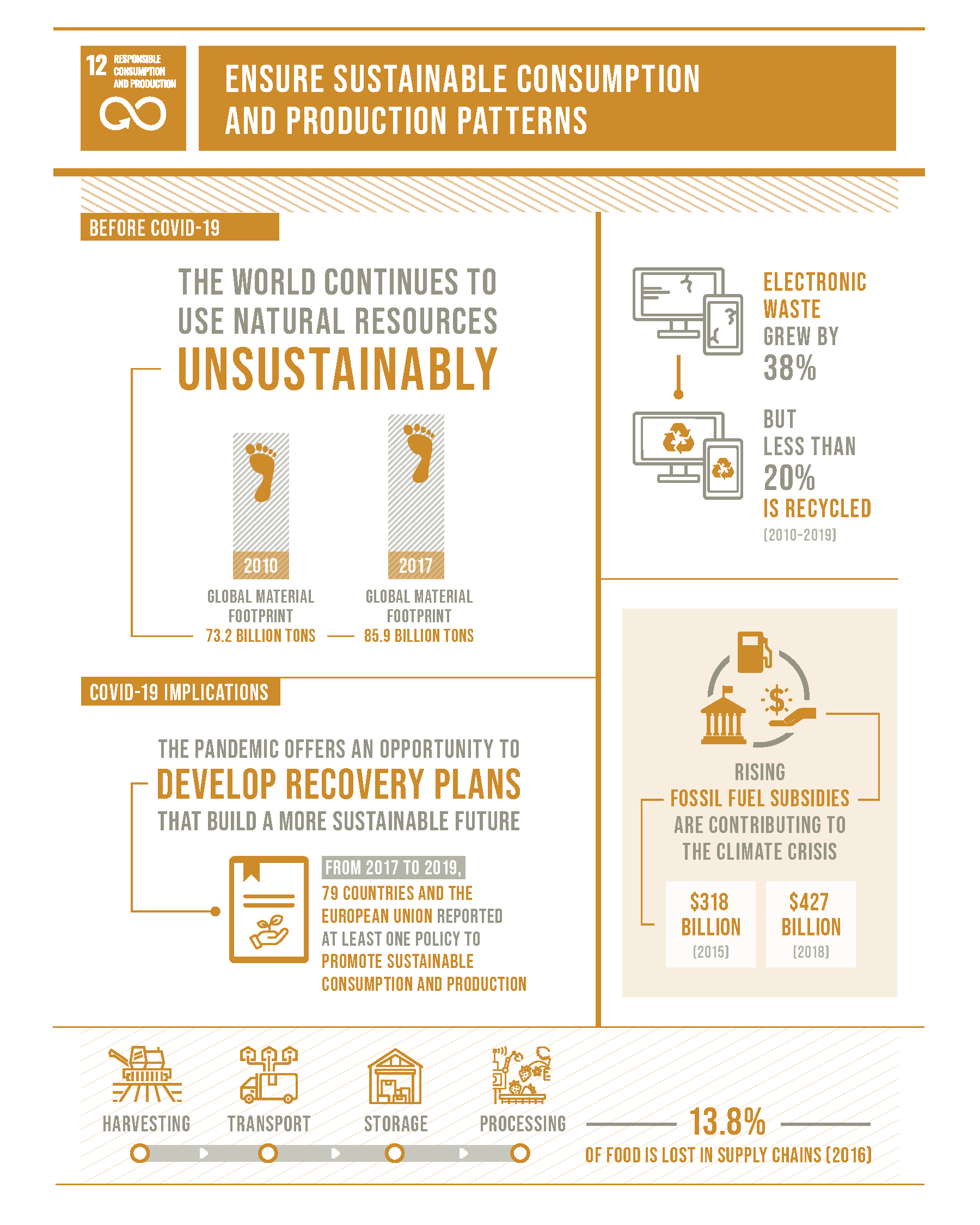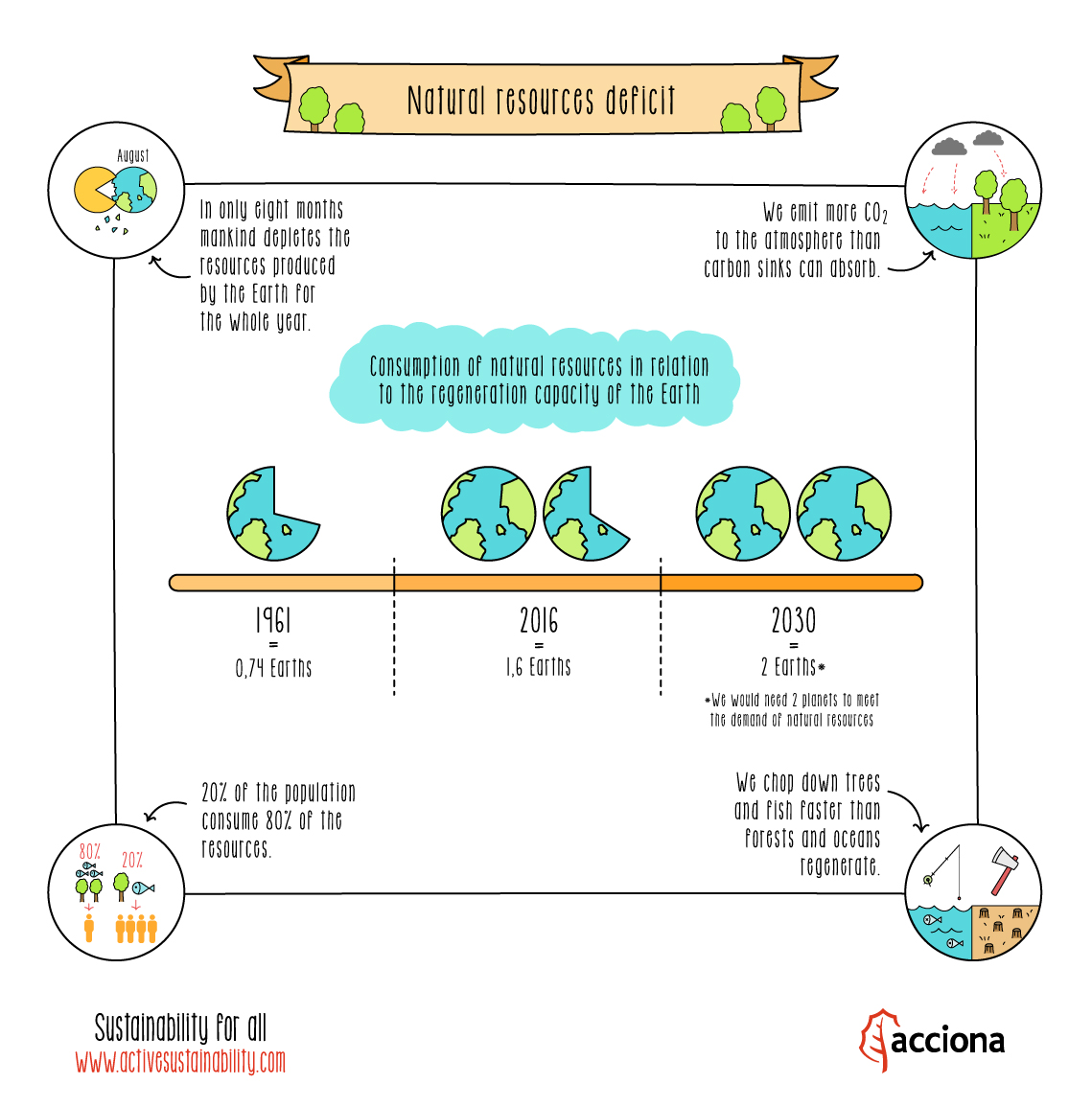What is the Problem?
Sustainable consumption is satisfying basic human needs without depleting the earth’s natural capital. The key process is producing materials from natural resources, such as food, water, energy, and raw materials, at a rate that allows for regeneration without compromising the needs of future generations (UNEP, 2021).
The devastating reality is that humans have been overconsuming and depleting resources too rapidly, resulting in the requirement of two (2) planets worth of resources by the year 2030 and an estimated three (3) planets in the year 2050 to keep up with global consumption patterns as populations continue to increase to 9.7 billion (United Nations, 2021b; Sustainability for All, 2021b).
What is YOUR Personal Consumption Impact?https://www.footprintcalculator.org/


Figure 2: “Natural Resources Deficit” (Sustainability for All, 2021b)
What Can WE Do?
Humans must be able to adapt consumer patterns to a circular economy instead of a Take-Make-Waste economic model.
What is wrong with humanity’s current economic model?
5 Steps That YOU Can Take
Consume less energy and use energy efficient products (ex. LED lightbulbs). If every person in the world made the switch to light bulbs that were energy efficient than the global cost savings would be about 120 billion USD every year (United Nations, 2021b). Individuals can consume less energy by turning lights off and unplugging appliances as individual households consume approximately 29 % of the Global energy which leads to about 21 % of resultant CO2 emissions globally (Blanco, 2014).
Reduce food waste by only buying what you need and donating excess to food banks, as every year around 1 trillion dollars’ worth of food is wasted because it is spoiled, which is about one third of all food produced that year (United Nations, 2021b).
Become a more thoughtful consumer by purchasing locally made goods and foods, reducing transportation emissions.
Buy only what you need, use second hand whenever possible, and repair before you repurchase! Buy products that will last a long time instead of short-term use. It has been determined that by purchasing products that are designed to be replaced often, it is costing up to 60,000 USD per person cumulatively during their lifetime (Sustainability For All, 2021c).
Stray away from single use objects that you replace often as they only contribute to our waste and pollution problems. If you must dispose, make sure it is recycled! For an example, electronic waste is becoming a vast polluter as it has grown by 38 % from 2010 to 2019, and only 20% was recycled correctly (United Nations, 2021b).
My Personal Commitment
I personally commit to reduce my use of single use products and to buy sustainably made products that are built to last vs. cheaper quality goods.
For an example I commit to no longer using disposable plastic wrap and will switch to only reusable containers and beeswax wrap to cover my leftover food! I am also pursuing a career as a sustainability professional and I commit to bringing these practices into my work ethics as well.
Some helpful resources to determine which brands are more sustainable are The Corporate Knights Global Rankings of 2020 and 2021!
2020 List https://www.corporateknights.com/reports/2020-global-100/2020-global-100-ranking-15795648/
2021 List https://www.corporateknights.com/reports/2021-global-100/2021-global-100-ranking-16115328/
What is YOUR Commitment?
What habits are you going to change? Please write your personal commitment to sustainable consumption in the comment section!
References
Blanco, G. et al. (2014). Drivers, Trends and Mitigation. In: Climate Change 2014: Mitigation of Climate Change. Contribution of Working Group III to the Fifth Assessment Report of the Intergovernmental Panel on Climate Change. Retrieved from, https://www.ipcc.ch/site/assets/uploads/2018/02/ipcc_wg3_ar5_chapter5.pdf
Peren, F. (2019). Unsustainable Future: The Mathematical Frame in Which we Live. Review of Business: Interdisciplinary Journal on Risk and Society, 39(2), 32–35.
Sustainability for All. (2021b). Natural Resources Deficit. Acciona. Retrieved from, https://www.activesustainability.com/environment/natural-resources-deficit/
Sustainability for All. (2021c). The Battle Against Planned Obsolescence. Acciona. Retrieved from, https://www.activesustainability.com/sustainable-development/battle-against-planned-obsolescence/
UN Environment Programme (UNEP). (2021). Sustainable consumption and production policies. The UN Environmental Programme. Retrieved from, https://www.unenvironment.org/explore-topics/resource-efficiency/what-we-do/sustainable-consumption-and-production-policies
United Nations. (2021b). Goal 12: Ensure sustainable consumption and production patterns. The United Nations. Retrieved from, https://www.un.org/sustainabledevelopment/sustainable-consumption-production/
Great article, thank you for sharing! I commit to not subscribe to ‘fast fashion’ trends and be more mindful with clothing and other purchases.
LikeLike
Great post – those videos were very engaging. I am also currently looking for a job in sustainability for when we graduate and hope to establish a career in the field. Beeswax wrap was a great suggestion and that is something I will be looking into as an alternative to plastic wrap in the future. I also commit to buying more items locally and from small scale producers to help reduce transportation and manufacturing emissions. For those items that cannot be purchased locally, the list of sustainable brands from Corporate Knights you provided will be very helpful!
LikeLike